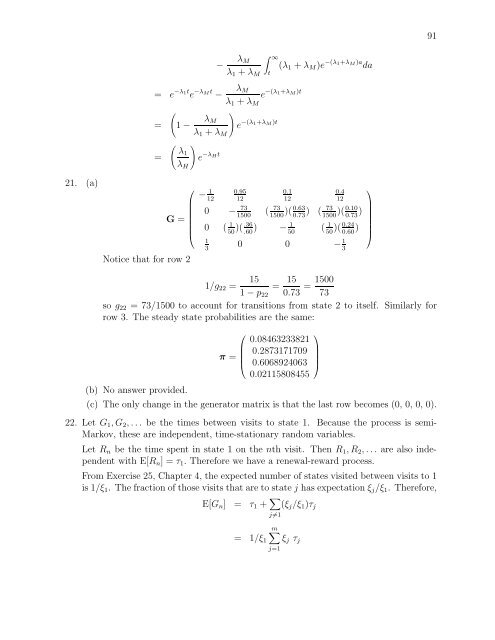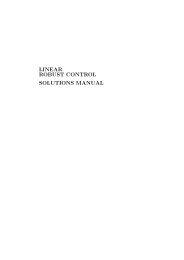SOLUTIONS MANUAL for Stochastic Modeling: Analysis and ...
SOLUTIONS MANUAL for Stochastic Modeling: Analysis and ...
SOLUTIONS MANUAL for Stochastic Modeling: Analysis and ...
Create successful ePaper yourself
Turn your PDF publications into a flip-book with our unique Google optimized e-Paper software.
91<br />
−<br />
λ M<br />
∫ ∞<br />
λ 1 + λ M t<br />
= e −λ1t e −λ M t − λ M<br />
e −(λ 1+λ M )t<br />
λ 1 + λ M<br />
(<br />
= 1 − λ )<br />
M<br />
e −(λ 1+λ M )t<br />
λ 1 + λ M<br />
=<br />
( )<br />
λ1<br />
e −λ Ht<br />
λ H<br />
(λ 1 + λ M )e −(λ 1+λ M )a da<br />
21. (a)<br />
⎛<br />
G =<br />
⎜<br />
⎝<br />
Notice that <strong>for</strong> row 2<br />
− 1 12<br />
0.95<br />
12<br />
0.1<br />
12<br />
0.4<br />
12<br />
0 − 73<br />
1500<br />
( 73 0.63<br />
)( 1500 0.73 ( 73 0.10<br />
)( 1500 0.73<br />
0 ( 1 .36<br />
)( 50 .60 − 1 50<br />
( 1 0.24<br />
)( 50 0.60<br />
1<br />
3<br />
0 0 − 1 3<br />
⎞<br />
⎟<br />
⎠<br />
1/g 22 = 15 = 15<br />
1 − p 22 0.73 = 1500<br />
73<br />
so g 22 =73/1500 to account <strong>for</strong> transitions from state 2 to itself. Similarly <strong>for</strong><br />
row 3. The steady state probabilities are the same:<br />
⎛<br />
π = ⎜<br />
⎝<br />
0.08463233821<br />
0.2873171709<br />
0.6068924063<br />
0.02115808455<br />
(b) No answer provided.<br />
(c) The only change in the generator matrix is that the last row becomes (0, 0, 0, 0).<br />
22. Let G 1 ,G 2 ,... be the times between visits to state 1. Because the process is semi-<br />
Markov, these are independent, time-stationary r<strong>and</strong>om variables.<br />
Let R n be the time spent in state 1 on the nth visit. Then R 1 ,R 2 ,... are also independent<br />
with E[R n ]=τ 1 . There<strong>for</strong>e we have a renewal-reward process.<br />
From Exercise 25, Chapter 4, the expected number of states visited between visits to 1<br />
is 1/ξ 1 . The fraction of those visits that are to state j has expectation ξ j /ξ 1 . There<strong>for</strong>e,<br />
E[G n ] = τ 1 +<br />
j≠1(ξ ∑ j /ξ 1 )τ j<br />
⎞<br />
⎟<br />
⎠<br />
∑ m<br />
= 1/ξ 1 ξ j τ j<br />
j=1















